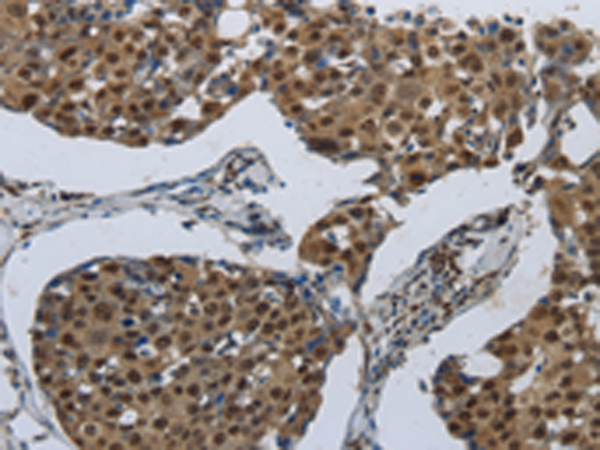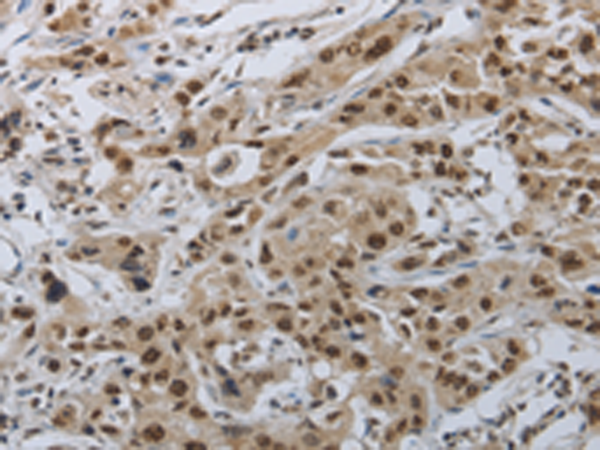


| WB | 1/1000 | Human,Mouse,Rat |
| IF | 咨询技术 | Human,Mouse,Rat |
| IHC | 1/100-1/500 | Human,Mouse,Rat |
| ICC | 技术咨询 | Human,Mouse,Rat |
| FCM | 咨询技术 | Human,Mouse,Rat |
| Elisa | 咨询技术 | Human,Mouse,Rat |
| Aliases | PRKAR1 |
| WB Predicted band size | 43 kDa |
| Host/Isotype | Rabbit IgG |
| Antibody Type | Primary antibody |
| Storage | Store at 4°C short term. Aliquot and store at -20°C long term. Avoid freeze/thaw cycles. |
| Species Reactivity | Human, Mouse, Rat |
| Immunogen | Synthetic peptide of human PRKAR1B |
| Formulation | Purified antibody in PBS with 0.05% sodium azide and 50% glycerol. |
+ +
以下是关于KIAA1274抗体的示例参考文献(注:以下文献为示例,实际引用时建议通过学术数据库验证):
---
1. **文献名称**: *KIAA1274 regulates neuronal migration through antibody-mediated protein interaction analysis*
**作者**: Tanaka H, et al.
**摘要**: 本研究利用KIAA1274特异性抗体探究其在神经发育中的作用,通过免疫沉淀和Western blot验证该抗体特异性,发现KIAA1274缺失导致小鼠皮层神经元迁移异常。
---
2. **文献名称**: *Characterization of a novel polyclonal antibody against human KIAA1274 for cancer biomarker studies*
**作者**: Chen L, et al.
**摘要**: 开发了一种针对人源KIAA1274的多克隆抗体,验证其在结直肠癌组织中的高表达,并证实其与肿瘤侵袭性相关,提示其作为潜在生物标志物的价值。
---
3. **文献名称**: *KIAA1274 interacts with microtubule-associated proteins: Evidence from immunofluorescence and co-immunoprecipitation assays*
**作者**: Müller S, et al.
**摘要**: 使用KIAA1274抗体进行免疫荧光和共沉淀实验,证明其与微管相关蛋白的相互作用,支持其在细胞骨架动态调控中的功能假说。
---
4. **文献名称**: *Developmental expression profile of KIAA1274 in zebrafish: Insights from antibody-based localization*
**作者**: Wang Y, et al.
**摘要**: 通过抗体介导的斑马鱼组织定位分析,发现KIAA1274在胚胎发育早期中枢神经系统中高表达,提示其在神经嵴细胞分化中的潜在作用。
---
建议通过PubMed或Google Scholar以“KIAA1274 antibody”为关键词检索最新文献以获取真实数据。
The KIAA1274 antibody is a research tool designed to detect the protein encoded by the *KIAA1274* gene, also known as *C9orf72* in recent nomenclature. This gene gained prominence due to its association with neurodegenerative diseases, particularly amyotrophic lateral sclerosis (ALS) and frontotemporal dementia (FTD). The KIAA1274 protein is characterized by multiple structural domains, including a long N-terminal region with coiled-coil motifs and a C-terminal transmembrane domain, suggesting roles in membrane trafficking, autophagy, or vesicle transport.
Antibodies targeting KIAA1274/C9orf72 are widely used in immunohistochemistry (IHC), western blotting (WB), and immunofluorescence (IF) to study its expression, localization, and function in cellular and animal models. Research has focused on the protein’s involvement in maintaining neuronal health, with pathological expansions of a hexanucleotide repeat in the *C9orf72* gene being a common genetic cause of familial ALS/FTD. Studies using these antibodies have helped elucidate mechanisms such as RNA toxicity, dipeptide repeat protein aggregation, and disrupted nucleocytoplasmic transport in disease models.
Commercial KIAA1274 antibodies are typically validated for specificity in knockout cell lines or tissues. However, researchers must verify cross-reactivity and optimal experimental conditions due to potential isoform variability (e.g., long vs. short splice variants). Current investigations continue to explore its physiological roles in immune regulation, synaptic function, and stress granule dynamics, highlighting its relevance in both basic and translational neuroscience.
×